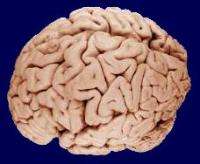Brain represents tools as temporary body parts, study confirms

Researchers have what they say is the first direct proof of a very old idea: that when we use a tool—even for just a few minutes—it changes the way our brain represents the size of our body. In other words, the tool becomes a part of what is known in psychology as our body schema, according to a report published in the June 23rd issue of Current Biology.
"Since the origin of the concept of body schema, the idea of its functional plasticity has always been taken for granted, even if no direct evidence has been provided until now," said Alessandro Farnč of INSERM and the Université Claude Bernard Lyon. "Our series of experiments provides the first, definitive demonstration that this century-old intuition is true."
In the new study, Farnč, Lucilla Cardinali, and their colleagues reasoned that if one incorporates a used tool into the body schema, his or her subsequent bodily movements should differ when compared to those performed before the tool was used.
Indeed, that is exactly what they saw. After using a mechanical grabber that extended their reach, people behaved as though their arm really was longer, they found. What's more, study participants perceived touches delivered on the elbow and middle fingertip of their arm as if they were farther apart after their use of the grabbing tool.
People still went on using their arm successfully following after tool use, but they managed tasks differently. That is, they grasped or pointed to object correctly, but they did not move their hand as quickly and overall took longer to complete the tasks.
It's a phenomenon each of us unconsciously experiences every day, the researchers said. The reason you were able to brush your teeth this morning without necessarily looking at your mouth or arm is because your toothbrush was integrated into your brain's representation of your arm.
The findings help to explain how it is that humans use tools so well.
"We believe this ability of our body representation to functionally adapt to incorporate tools is the fundamental basis of skillful tool use," Cardinali said. "Once the tool is incorporated in the body schema, it can be maneuvered and controlled as if it were a body part itself."
• Join PhysOrg.com on Facebook!
• Follow PhysOrg.com on Twitter!
Source: Cell Press (news : web)















